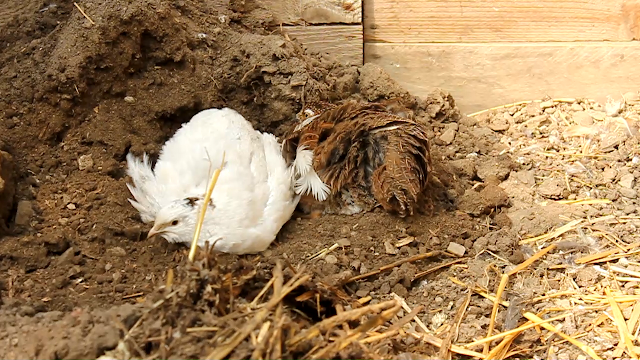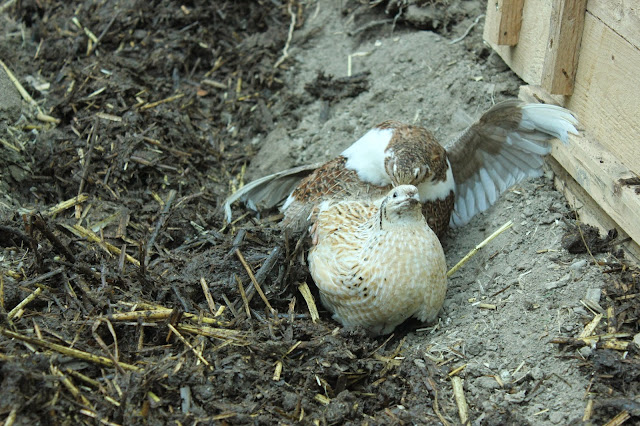You know how it is, you've been hoping and planning for an event and just as you finally start to get ready for action, your poultry decide they've waited long enough for an outcome and take charge.
Fred and his best friend Dorothy keeping guard whilst Ginger is laying.
Well, a couple of weeks ago I started reading about fatal genes in the Golden quail. There is a lot of conflicting information because well it's genetics and thus exceedingly complicated. Even the nomenclature 'Golden' quail is somewhat controversial, in French these quail are know as Isabelle but in English there are two recognised type of golden quail - the Italian and the Manchurian. You will read in some papers and articles that it is the latter or the former that carry the fatal gene. This however, is further complicated by the fact that some articles I've read, insist that the Italian and Manchurian quail are one and the same! In my experience with purchased hatching eggs and through talking to other quail keepers, it is certainly true here, that all Golden quail seem very frail and have poor hatch and survival rates. My golden quail I've had now for three years from hatch and although they
wouldn't get any prizes from purists, as all the feathers are patterned
differently, they are gold and they are healthy.
However, not to tempt fate nor F.B. Hutt et al, I have decided to steer away from crossing gold with gold of any sort. In France this makes even more sense, as the Isabelle are said to have been raised from a very small gene pool, just 20 original eggs brought in from Portugal. Thus on top of the fatal gene issue, we have consanguinity to add to and exacerbate the problem.
However, not to tempt fate nor F.B. Hutt et al, I have decided to steer away from crossing gold with gold of any sort. In France this makes even more sense, as the Isabelle are said to have been raised from a very small gene pool, just 20 original eggs brought in from Portugal. Thus on top of the fatal gene issue, we have consanguinity to add to and exacerbate the problem.
Some two weeks ago on a visit to our local organic dairy farm to collect our milk and where they keep quail, I asked if they had an English White or Range or any other colour other than gold to sell me. In fact they had a lovely Tuxedo, which I instantly wanted but could not have, as he was their only example of the colour. So I asked to borrow him for a week. In the event and just in case there was some friction between my quail and Fred, I brought his friend with him. This English White quail was of undetermined sex but I called 'her' Dorothy after Dorothy Lamour because she had a heart shaped pattern on the back of her neck. This complicated things rather as I always felt she was keeping a beady eye on Fred and perhaps rather cramping his style!
One of last year's nests under the rosemary
In my reading around the subject of wild quail because this is the way I am sure I will get the happiest and healthiest creatures, I found that the female is drawn to start nesting by hearing the male cry. Apocryphal or not, last year when I had a male quail, my female quail made nests. This year when they started laying in early April, they were just laying in a random, devil-may-care sort of way, single eggs in different places each day. However, the day after Fred arrived I noticed one of my golden quail hiding behind the pallet wood vertical garden shelving in the greenhouse and I noticed her return there the next day too. On the following day I investigated and found three eggs in a row, it is a really tight squeeze in there, so every time she got up from laying she left the eggs in a rather haphazard way. However, on subsequent days I noticed she would gather them together before she laid and that she was going back in there, during the day, seemingly both to check on the eggs and to turn them too. This quail I now named Ginger, for obvious reasons.
I was now getting very excited, Ginger had laid six eggs in all but Fred was destined to go back to the farm the very next day when we went for the milk. From all I have read, I am still not totally sure how important the male is, nor exactly sure if he is involved in sitting. As wild quail, are very private, shy birds, there is no great body of research on their behaviours. They do actually have wild quail on the farm but assure me they have never seen two birds together on a nest but my belief is, from watching Fred, that in the early stages of nesting even if the male does not sit he is very near by. According to a paper I read on the subject; Nesting and Parental Behavior in Domestic Common Quail, Orcutt and Orcutt (1976), the male sits within 30cms of the nest for at least the laying of the eggs and for some part of the sitting. This was true of Fred as you can see from the photograph above (top) and the film. So I decided to ask to borrow Fred for another week, just in case Ginger decided to sit. In the event Ginger started to sit that very same day.
I was really worried now, as it meant I would have to leave Ginger outside in the greenhouse all night rather than put her away with the others in their little wooden house. We have a variety of predators here but the worst for quail are rats, which although I shouldn't say it, I have not seen for several years. We also had a weasel here quite recently but I was hoping that Ginger was well enough hidden. I placed a board in front of her at night and a couple of bricks along the front of the greenhouse door where there was a slight gap. How happy I was the next morning to see her still sitting and in good health!
Fred caught snacking again with friends
I also read in the Orcutt article, that they actually had to remove their male from the breeding pen, as he was showing less interest in the nest and he was being attacked. I did however, wonder at this behaviour from Ginger. She was particularly aggressive towards Fred when she saw him around the food bowl in the morning and I did wonder if she really wanted him to be guarding the nest or even sitting. In an Experimental Study of Nesting by Coturnix Quail, Vernon C. Stevens, The Journal of Wildlife Management, (1961) the author seems to indicate a more proactive role for the male. However, I was rather hoping Fred would not be that important to Ginger, as by the next weekend he would have to go back to the farm!
So here I am with my design for a secure quail breeding area still in the workshop and Ginger already sitting and on her 6th day of incubation. Fred is still in the dog house and Dorothy possibly quite happy about it. Whatever happens, I have backup in the form of my little Cochin Snow Queen who is already sitting on some of the other quail eggs, which I am hoping are fertile by Fred too. If Ginger gives up then I will transfer the eggs to her.
One of my most important precautions for Ginger though, is in nutritional support. As you can see in the photos, now they are laying, I have been stocking up the greenhouse with compost and keeping the large compost bins closed as the chicks have had their share. This is, however, part of my Spring schedule, spreading compost in order to get the greenhouse ready for planting. As our principal compost bins are chock full of arthropods, I have set up a 'holding bin' actually in the greenhouse and Ginger gets the first pick of this every morning. I am hoping all the methionine and the B complex vitamins this food will provide, will keep her stress levels down to a minimum and save Fred from a few plucked feathers.
Part Two the update is here
Fingers crossed... and now if you'd like to sit back and watch the film:
Fred snacking again this time on a courgette/zucchini.
 Thanks for dropping by and if you
have enjoyed this piece and found it useful think about sharing it and
also maybe about joining this blog. Please also feel free to ask
questions or make comments in the section below.
Thanks for dropping by and if you
have enjoyed this piece and found it useful think about sharing it and
also maybe about joining this blog. Please also feel free to ask
questions or make comments in the section below.
Part Two the update is here
Fingers crossed... and now if you'd like to sit back and watch the film:
Fred snacking again this time on a courgette/zucchini.
 Thanks for dropping by and if you
have enjoyed this piece and found it useful think about sharing it and
also maybe about joining this blog. Please also feel free to ask
questions or make comments in the section below.
Thanks for dropping by and if you
have enjoyed this piece and found it useful think about sharing it and
also maybe about joining this blog. Please also feel free to ask
questions or make comments in the section below.










